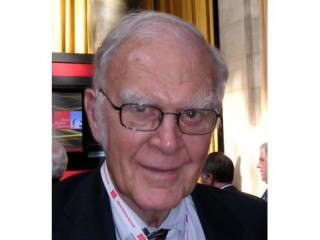
F. Sherwood Rowland biography
Date of birth : 1927-06-28
Date of death : 2012-03-10
Birthplace : Delaware, Ohio, United States
Nationality : American
Category : Science and Technology
Last modified : 2011-09-19
Credited as : chemist, Nobel Prize for Chemistry, chlorofluorocarbons CFCs
10 votes so far
Born in Delaware, Ohio, Rowland received his B.A. from Ohio Wesleyan University in 1948. He then earned his M.S. in 1951 and his Ph.D. in 1952, both from the University of Chicago. He held academic posts at Princeton University (1952-56) and at the University of Kansas (1956-64) before becoming a professor of chemistry at the University of California, Irvine, in 1964. At Irvine in the early 1970s he began working with Mario Molina. Rowland was elected to the National Academy of Sciences in 1978, and served as a president of American Association for the Advancement of Science (AAAS) in 1993.
His best-known work is the discovery that chlorofluorocarbons contribute to ozone depletion.
He received the 1995 Nobel Prize in Chemistry along with Mario Molina of MIT and Paul Crutzen of the Max Planck Institute for Chemistry in Mainz, Germany. The Physical Sciences Building at the University of California, Irvine, which held his laboratories for many years, was renamed Rowland Hall in his honor that same year.
Awards and honors:
ACS Richard Tolman Medal 1976
APS Leo Szilard Award 1979
Tyler Prize for Environmental Achievement 1983 (with Mario J. Molina)
Charles A. Dana Award 1987
Peter Debye Award in Physical Chemistry 1993
AGU Roger Revelle Medal 1994
WCC Albert Einstein World Award of Science 1994
Nobel Prize for Chemistry 1995 (with Paul J. Crutzen and Mario J. Molina)
Japan Prize 1989
American Academy of Arts and Sciences
American Association for the Advancement of Science President, 1992
American Philosophical Society
American Physical Society
Institute of Medicine
National Academy of Sciences 1978
National Academy of Sciences Foreign Secretary, 1994-2002
Royal Society Foreign Member, 2004
US Atomic Energy Commission Fellowship, 1952


















